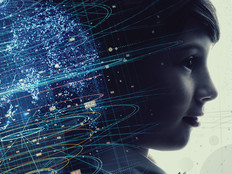Major evolutions in technology are often hard to pin to a specific time or place, but this is not the case for artificial intelligence. Although AI has been around in various forms for decades — including Microsoft’s Clippy and Google’s autofill feature for online searches — its recent evolution has made it impossible to ignore.
“When we talk about AI today, what we’re really talking about is post-Nov. 30: the rollout of generative AI, and ChatGPT as the first one out of the gate,” says Mark Schneider, director of the Department of Education’s Institute of Education Sciences.
After the rollout, K–12 leaders and IT experts found themselves divided on how to use generative AI and whether to even allow it. Some educators encouraged the use of ChatGPT in the classroom, while others tried to ban the tech.
Today, around 33 percent of K–12 teachers, staff and administrators use generative AI for classroom tasks, but only 15 percent feel prepared to oversee its use in the classroom, according to an Imagine Learning report.
LEARN MORE: Generative AI gets dangerously smart for education.
However, some organizations are working to make the technology more accessible and suitable for K–12 education. Merlyn Mind released the first large language model for education this summer. And Schneider notes that school districts can’t afford to miss out on this trending technology.
“Is it even possible to say no? How can you say, no, you can’t put ChatGPT on your school Chromebook, but when students go home, there it is at home,” he says.
To avoid widening the digital divide on student access to AI, schools must embrace the technology, he adds. He shared three ways it can be used to improve teaching and learning.
1. Individualize Instruction with AI for Affordable Tutoring
Individualizing instruction is one of the best ways educators can use generative AI tools in their classrooms, Schneider says.
“I want to be clear, this is not individual instruction, this is individualized instruction,” he says. “Individualized instruction is the feedback, the tutoring, the mentoring, all tailored to the needs of that individual student.”
Using AI for individualized instruction can help students learn in the ways that work best for them and at their own pace while still working with others in the classroom. It can also help bring down the cost of tutoring. “We know tutoring works,” Schneider says. “We also know that it works because it’s individualized. But right now, it’s mostly humans, and it’s just too expensive.”
Click the banner below to transform your K–12 classrooms for modern learning.
Schneider adds that tutoring and other uses of generative AI in the classroom still require complementary human oversight and guidance.
“There are always going to be humans in the loop,” he says. “We cannot give up our human control and intervention and input.”
2. Provide Better Accommodations for Students with Disabilities
Of the teachers, staff and administrators surveyed in the Imagine Learning report, 90 percent said that generative AI will make education more accessible. One way this may manifest is through AI screenings for students with disabilities.
“Most of the time, screening for special needs is just not deep enough,” Schneider says. “For example, we don’t have enough speech and language pathologists to assess everybody in depth.”
Generative AI tools could solve that problem, helping to flag students who need extra support or accommodations with universal screening. “Then, based on that information and always in cooperation and collaboration with teachers, we develop a treatment plan based on the best evidence,” Schneider says.
3. Automate Tasks and Lesson Plans to Ease Educators’ Workloads
As schools continue to look for ways to ease staff shortages, they may find help from generative AI. Educators are increasingly turning to this technology to automate manual and repetitive tasks.
Earlier this year, 37 percent of teachers planning to leave their jobs cited unsustainable work expectations as their reason in a McKinsey survey. Meanwhile, the Imagine Learning report found that 44 percent of educators surveyed think the use of generative AI has made their jobs easier.
“Teachers have been using online resources for lesson plans for a long time,” Schneider says. “Because AI is built on what one finds on the internet, teachers could fashion it into something that works for them and works for their students without having to start from square zero.”
DIVE DEEPER: Create a policy for artificial intelligence in your K–12 schools.
He notes that generative AI could also help educators manage repetitive tasks such as filling out forms or finding evidence-based materials for teaching online.
“We’re approaching our investments in AI in the classroom to make teachers’ lives easier and free up time for them to do the things that only teachers can do — to be a human.”










